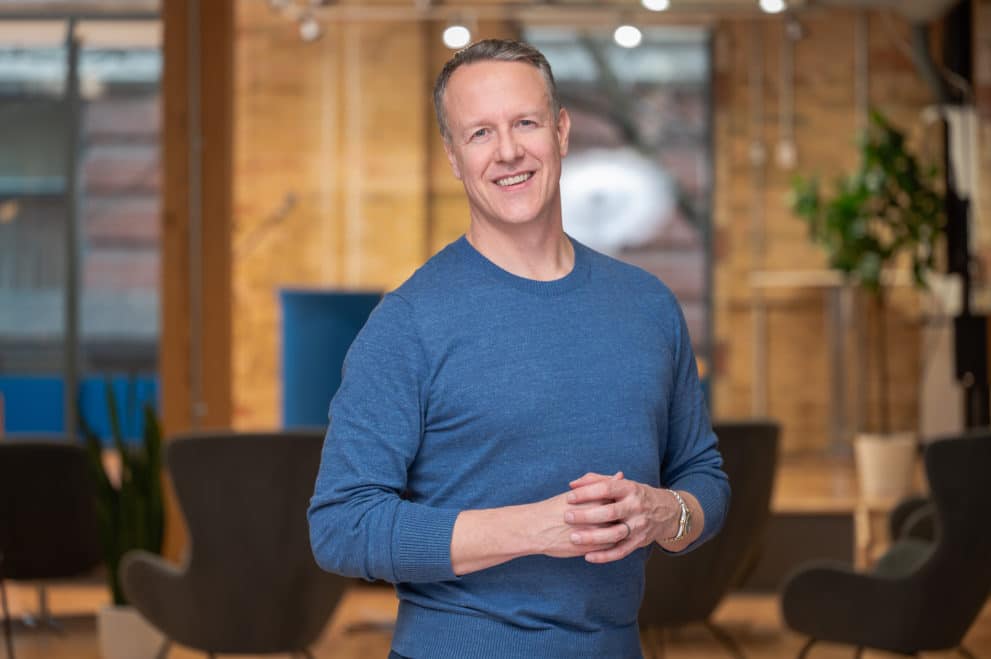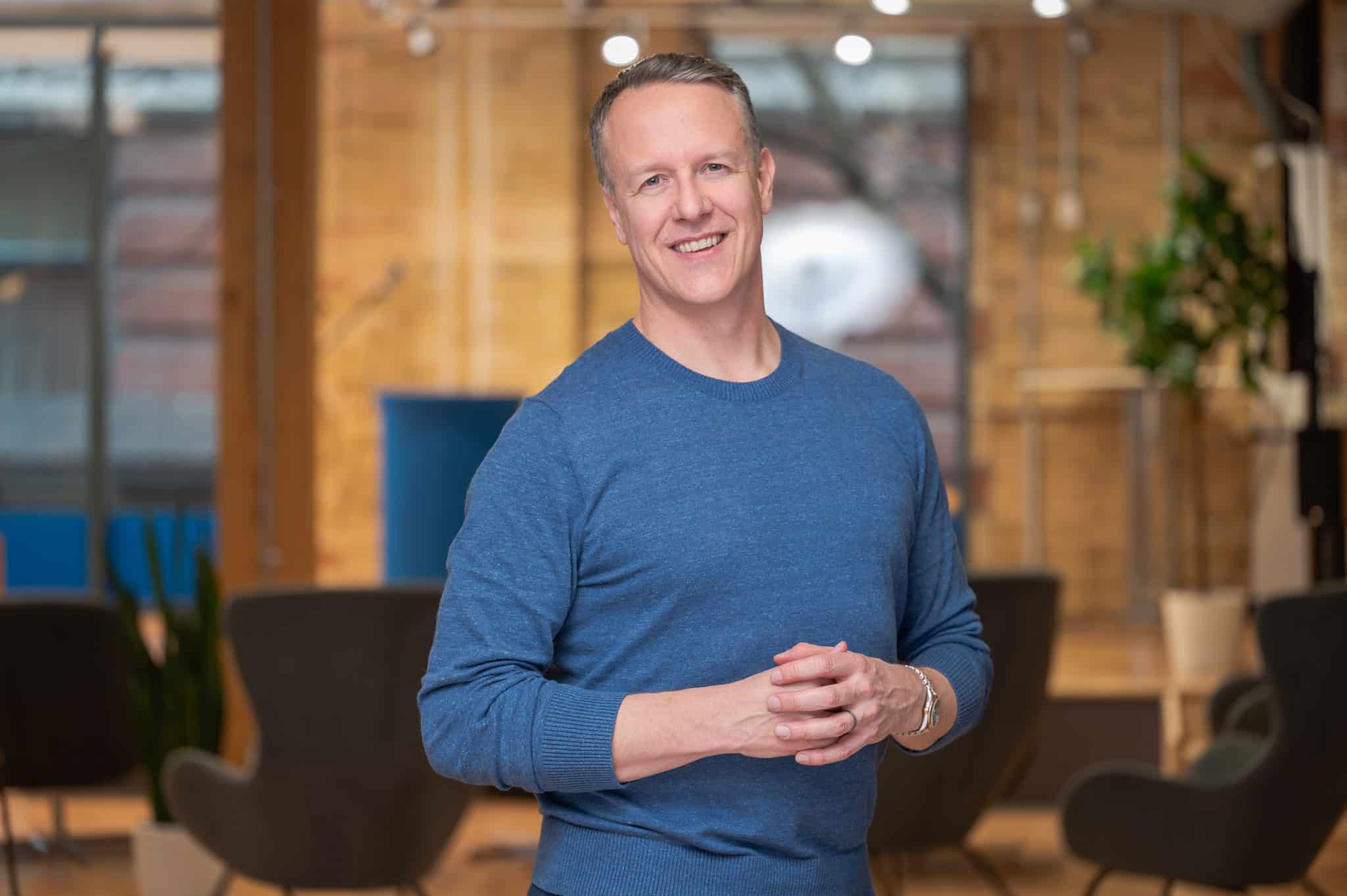
 Investor relations isn’t something that most investors spend a lot of time thinking about.
Investor relations isn’t something that most investors spend a lot of time thinking about.
But public companies do. Or at least they do now. Think about it: some companies command sky-high valuations and others seem doomed to become permanent value traps, never unlocking their true potential.
What’s the difference? Sure, a railway might not ever achieve the valuation multiples that high-flying Silicon Valley techs do, but what about when two companies of a similar profile have vastly differing valuations? The difference may come down to how the companies communicate their value proposition to the market. And it can have wide-ranging and forever lasting impacts on its cap table, its ability to raise money and its success in attracting top-level talent.
In 2006, Darrell Heaps saw the problem and set out to solve it with technology, forming Q4 Inc. (TSX:QFOR). Today, Q4 enjoys double-digit growth and a roster of clients that reads like a Who’s Who list.
Cantech Letter sat down with Heaps to talk about the past, present and future of Q4.
Darrell, can you tell us a bit about Q4’s history?
I founded Q4 back in 2006 with the mission of helping our clients win in the capital markets and excel at investor relations. Our first product was a web based content management system that we sold to public companies. In 2010, following the financial crisis, we pivoted to focus on building out our IR communication and engagement solutions to cover the core use cases for IROs. This was the catalyst for our growth. We grew from roughly 100 customers in 2010 to over 1,000 in 2015, to nearly 3,000 logos today across our four main product categories of websites, virtual events, IR CRM and analytics – all delivered via our integrated platform called Capital Connect.
As the business has grown, our vision has expanded to uniting the three sides of the market across our platform, with goals to bring efficiency and accuracy to investor relations, corporate access and research.
Today, more than 10 million investors visit our network of websites each month with over 350,000 logging into virtual events we host for our clients. With this volume of traffic flowing across our platform, we have an extensive view into the interactions of companies, investors, and the sell-side. We use this data to provide insights and analytics to our clients on which investors they should be prioritizing and targeting for outreach.
“Today, more than 10 million investors visit our network of websites each month with over 350,000 logging into virtual events we host for our clients. With this volume of traffic flowing across our platform, we have an extensive view into the interactions of companies, investors, and the sell-side.”
What problem is the company solving? What did current clients do before this solution was available?
The sell-side has been in decline for more than 10 years due to regulatory and technological changes in the market. During this time, fewer companies are being covered and do not have the support of banks in identifying, targeting, and engaging with the right investors. This causes a lack of awareness, lack of liquidity, and it negatively impacts valuation because of inefficient markets. We solve this problem by helping companies understand their market, their current shareholders and potential investors, and how best to identify, communicate, target, and engage with the right investors, at the right time. This ultimately helps our clients achieve fair and superior valuation, or as we describe it, win in the capital markets.
Before Q4, companies relied on a handful of disconnected products from different vendors to try and cobble together a solution. This is normally ineffective, lacks insightful analytics, and takes a lot of time and effort away from high value IR activities.
What kind of insight can a pubco glean from using Capital Connect?
By using Capital Connect and engagement analytics, companies can understand who the investors are that engage with their communications and touchpoints in the market. This includes website visits, email interactions, event attendance to earnings calls, and investor days. In addition, because we have this interaction data across thousands of touchpoints, we are able to provide benchmarking against peers and targeting recommendations based on both direct data and insights obtained at the platform level. This enables us to provide targeting recommendations to issuers, but in the near future, we will also be able to provide recommendations to the sell-side and other market participants.
“We launched the new events platform in the spring of 2021 and we are happy to share that today, we are running more than 1,200 events per quarter on this platform and have achieved a 99+% reliability rate.”
Can you tell us about a new product, your Q4 Virtual Events platform?
Starting in early 2021, we set out to build the best capital markets virtual events platform. After years of working with 3rd party vendors that do not specialize in the capital markets, suffer from poor availability, and averaged a 6-7% event issue rate, we knew it was time for a change. It was clear there was a need for an events platform that was designed from the ground up to serve the needs of the market, specifically for earnings calls, investor days, and investor conferences.
We launched the new events platform in the spring of 2021 and we are happy to share that today, we are running more than 1,200 events per quarter on this platform and have achieved a 99+% reliability rate. Or, less than 1% of our events hosted on the platform have an issue. This is unprecedented and is a key element in our ability to significantly grow this aspect of our business.
In addition, bringing this platform to market has been paramount in our gross margin expansion strategy, which worked exceptionally well in 2022. This is a key component of our margin expansion strategy for 2023.
What is the total addressable size of Q4’s market? What penetration rate have you achieved against that number?
There are roughly 40,000 public companies, of which we have just under 2,700, or 9% globally. This is purely from a logo perspective, if we look at it by product category we have even more room to grow across all of our products.
“Margin expansion is a key component to our profitable growth strategy and delivering profitable operations by Q4’23.”
How, exactly, does Q4 make money? Is there an internal push toward higher margin offerings?
Roughly 80% of our revenue is recurring and comes from subscription based SaaS contracts. 10% is re-occurring in nature, such as investor days, and the final 10% is service based offerings. Since 2021, we have been on an aggressive margin expansion strategy, focused on expanding margins from 56% to mid 60s for year end 2022 and into the mid 70s by year end 2023. This strategy included migrating to our own virtual events platform, utilizing fixed data contracts, and more recently the migration of roughly 20% of our workforce to Latin America. As of Q3’22 we posted 59%, which we were pleased with. This did not include any benefit of our migration to LATAM, which will show up in our fourth quarter numbers to be released on March 1.
This margin expansion is a key component to our profitable growth strategy and delivering profitable operations by Q4’23. When combined with our Opex reduction and cost management strategy, we feel very good about this trajectory.
Q4 sometimes talks about behavioral analytics and “next gen” targeting in IR. What do these things mean to you?
What makes Q4 so unique is that we use our unified platform to deliver a broad range of products designed to help IROs communicate and engage with the market. In doing so, at the scale we are operating, it gives us a view into the behaviour of over 10 million investors, both institutional and retail. We are able to understand their behaviour on a company by company basis, but also in aggregate, which is incredibly powerful in terms of understanding patterns and being able to match companies and investors. This ability to match is the core of next gen targeting. Being able to understand patterns over time and combining this with other market data, allows us to provide recommendations to our clients as to who to target (down to individual level) and equally as important, when to do so.
This combination of the right data, insight, and tools, are all designed to help IR teams make better decisions as to who to focus on, which leads to better meetings and better shareholders…and ultimately premium valuation.
Your third quarter results, released in November, revealed that you continue to post double-digit revenue growth but also that your recurring revenue is growing rapidly. What is driving this?
Our business and our clients operate within a massive global market. This offers the opportunity for QFOR to not only endure, but to grow profitably for many years ahead, even in the face of uncertain macro conditions.
With approximately 40,000 publicly traded companies around the world, we have just under 2,700 of the companies as clients, with about 45% using two or more products. We have the ability to grow by acquiring more clients and by improving the adoption of additional products.
The capital markets took a beating in 2022 and we have seen more public companies get acquired or delisted than ever before, making it harder to benefit from new logos and IPOs. Nonetheless, we have continued to grow our wallet share by increasing the adoption of our existing products.
So when we get to the other side of this valley, we will be better positioned than ever to grow in all market conditions, whether that is adding new clients or helping our clients adopt more products on our platform. This approach of new logo plus expansion is key to driving growth. Moving forward, as the capital markets get back to growth mode and IPOs return, this will be a tremendous tail wind to help us grow even faster.
The first two of these are what I see happening right now, the third is a future projection. I have no idea when this will happen, but I do know how much we have improved the business over the short term and the impact this is having today and will have tomorrow. And in the spirit of transparency, I want our investors to be as excited about our prospects as I am. I look forward to proudly reporting on these outcomes in subsequent results.
2022 was one of the worst years in recent memory for the capital markets, with QFOR stock being no exception. What are you hearing from shareholders and how has it impacted your business?
The impact to business has been two fold. The first is the lack of IPOs, which typically make up roughly a third of our new logo acquisitions. In response to this, we have focused on our expansion opportunities with our current clients and also competitive displacements. As I previously mentioned, this has allowed us to continue growing in tough markets. The second, is an increase in m&a and delisting during the year. This has made it more difficult for us to grow our client count due to uncontrollable churn. Similar to the first, we have doubled down on serving our clients and adding value, while also ramping up our efforts on winning clients from competitors.
As far as QFOR stock is concerned, I’ve used it as a buying opportunity and accumulated stock whenever I could from last summer through the end of the calendar year. And I intend to continue buying for as long as I can.
Here are my top 3 reasons:
1. The stock is incredibly discounted relative to our ambitions, our potential, and expected results. So, as a long term holder, I view it as an opportunity to accumulate more shares at a discount.
2. Profitability. We have implemented strategic initiatives that control costs and focus our spending in the most impactful parts of our business. This will accelerate our breakthrough to profitably in 2023. As we move closer to reporting each quarter, these impacts and outcomes will become more and more visible and material to our bottom line.
3. Our business and our clients operate within a large global market, which offers the opportunity for QFOR to not only endure, but to grow profitably far into the future, regardless of uncertain macro conditions.
What do you want Q4 to accomplish in 2023?
Our goal for 2023 is to deliver on our profitable growth plan, delivering cash positive results in Q3, and to be EBITDA positive in Q4. I feel great about the progress we made in Q3 and the benefits we are realizing to date. The heavy lifting is behind us and the impact of these changes will be seen in Q4 and accelerate in 2023.





 Share
Share Tweet
Tweet Share
Share




Comment